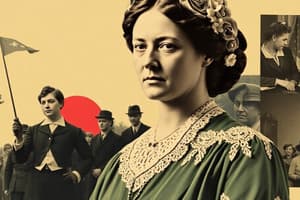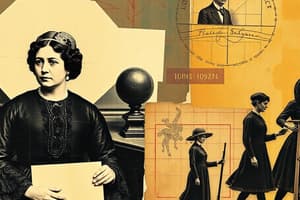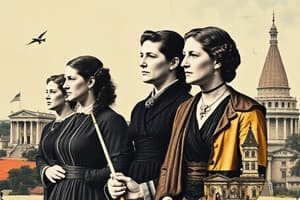Podcast
Questions and Answers
What differing opinions did women have regarding the Fifteenth Amendment?
What differing opinions did women have regarding the Fifteenth Amendment?
- All women supported the amendment.
- Some women opposed it because it enfranchised African American men before women. (correct)
- All women believed it was crucial for advancing overall suffrage.
- Some women felt it should not include any voting rights for men.
Which two organizations were founded by women with differing views on suffrage?
Which two organizations were founded by women with differing views on suffrage?
- National Woman Suffrage Association and American Woman Suffrage Association (correct)
- Women's National Association and Pro-Women Alliance
- Female Suffragists Council and American Women’s Political Association
- National Woman Suffrage Association and American Woman Suffrage League
What approach did some suffragists prefer for achieving women's voting rights?
What approach did some suffragists prefer for achieving women's voting rights?
- Lobbying at the federal level only.
- A violent takeover of government seats.
- Pursuing state-by-state legislation. (correct)
- Ignoring state laws and pushing for an international vote.
How did Elizabeth Cady Stanton react to criticisms about her views on race and gender?
How did Elizabeth Cady Stanton react to criticisms about her views on race and gender?
What significant action did Elizabeth Cady Stanton take in 1866?
What significant action did Elizabeth Cady Stanton take in 1866?
What was Elizabeth's main role in the women's rights movement?
What was Elizabeth's main role in the women's rights movement?
Which phrase best describes Elizabeth's feelings about her role as a mother?
Which phrase best describes Elizabeth's feelings about her role as a mother?
What was the main goal that emerged from the Seneca Falls convention?
What was the main goal that emerged from the Seneca Falls convention?
How did Elizabeth and Susan complement each other in their partnership?
How did Elizabeth and Susan complement each other in their partnership?
What significant conflict arose between Elizabeth, Susan, and their cause after the Civil War?
What significant conflict arose between Elizabeth, Susan, and their cause after the Civil War?
What quality of Susan often caused frustration for Elizabeth?
What quality of Susan often caused frustration for Elizabeth?
What was the nature of the relationship between Elizabeth and Susan despite their arguments?
What was the nature of the relationship between Elizabeth and Susan despite their arguments?
What differing priorities emerged within the women of the suffrage movement during the Civil War?
What differing priorities emerged within the women of the suffrage movement during the Civil War?
What motivated Elizabeth Cady Stanton to take action against the legal system she observed as a child?
What motivated Elizabeth Cady Stanton to take action against the legal system she observed as a child?
Which act of defiance did Elizabeth Cady Stanton demonstrate in her marriage?
Which act of defiance did Elizabeth Cady Stanton demonstrate in her marriage?
What significant event did Elizabeth Cady Stanton attend where she met Lucretia Mott?
What significant event did Elizabeth Cady Stanton attend where she met Lucretia Mott?
What was Elizabeth Cady Stanton's reaction to the male delegates voting to ban women from participating in the convention?
What was Elizabeth Cady Stanton's reaction to the male delegates voting to ban women from participating in the convention?
How did Elizabeth Cady Stanton use scissors in a symbolic act during her life?
How did Elizabeth Cady Stanton use scissors in a symbolic act during her life?
Why did Elizabeth Cady Stanton feel compelled to write The Woman's Bible?
Why did Elizabeth Cady Stanton feel compelled to write The Woman's Bible?
What was the outcome for Elizabeth's brothers, and how did it affect her father?
What was the outcome for Elizabeth's brothers, and how did it affect her father?
What overarching theme can be seen in Elizabeth Cady Stanton's life and actions?
What overarching theme can be seen in Elizabeth Cady Stanton's life and actions?
Flashcards
Who was Elizabeth Cady Stanton?
Who was Elizabeth Cady Stanton?
Elizabeth Cady Stanton was a prominent feminist and women's rights activist. Her work focused on the rights and opportunities of women, particularly the right to vote and own property.
What was Elizabeth Cady Stanton known for?
What was Elizabeth Cady Stanton known for?
Elizabeth Cady Stanton was a strong proponent of women's rights and equality, challenging the traditional roles and expectations imposed upon women during her time.
How did Elizabeth Cady Stanton challenge societal norms?
How did Elizabeth Cady Stanton challenge societal norms?
Elizabeth Cady Stanton refused to conform to the societal expectations of her time. She rejected the traditional vow of obedience to husbands, used her own name instead of her husband's, and refused to be addressed as 'Mrs.', asserting her identity as Elizabeth Cady Stanton.
What event sparked Elizabeth Cady Stanton's activism?
What event sparked Elizabeth Cady Stanton's activism?
Signup and view all the flashcards
What experiences influenced Elizabeth Cady Stanton's early views on gender roles?
What experiences influenced Elizabeth Cady Stanton's early views on gender roles?
Signup and view all the flashcards
How did Elizabeth Cady Stanton challenge religious teachings?
How did Elizabeth Cady Stanton challenge religious teachings?
Signup and view all the flashcards
How did Elizabeth Cady Stanton's activism extend beyond the US?
How did Elizabeth Cady Stanton's activism extend beyond the US?
Signup and view all the flashcards
What were Elizabeth Cady Stanton's primary goals for women's rights?
What were Elizabeth Cady Stanton's primary goals for women's rights?
Signup and view all the flashcards
Declaration of Sentiments
Declaration of Sentiments
Signup and view all the flashcards
Women's Suffrage Movement
Women's Suffrage Movement
Signup and view all the flashcards
Elizabeth Cady Stanton & Susan B. Anthony
Elizabeth Cady Stanton & Susan B. Anthony
Signup and view all the flashcards
Elizabeth Cady Stanton's Views on Racial Equality
Elizabeth Cady Stanton's Views on Racial Equality
Signup and view all the flashcards
Stanton & Anthony's Disagreements
Stanton & Anthony's Disagreements
Signup and view all the flashcards
Stanton & Anthony's Complementary Skills
Stanton & Anthony's Complementary Skills
Signup and view all the flashcards
Civil War and Suffrage Movement
Civil War and Suffrage Movement
Signup and view all the flashcards
Internal Disagreements in the Suffrage Movement
Internal Disagreements in the Suffrage Movement
Signup and view all the flashcards
What was the women's suffrage movement?
What was the women's suffrage movement?
Signup and view all the flashcards
What conflict arose within the women's suffrage movement?
What conflict arose within the women's suffrage movement?
Signup and view all the flashcards
How did tactics divide the suffrage movement?
How did tactics divide the suffrage movement?
Signup and view all the flashcards
What were some of the differences in the suffrage movement's approach?
What were some of the differences in the suffrage movement's approach?
Signup and view all the flashcards
How did Elizabeth Cady Stanton challenge limitations on women's political participation?
How did Elizabeth Cady Stanton challenge limitations on women's political participation?
Signup and view all the flashcards
Study Notes
Elizabeth Cady Stanton
- Born November 12, 1815 – October 26, 1902
- Ten-year-old Elizabeth watched her father, a lawyer, struggle to help a woman whose husband died. She inherited nothing and was at the mercy of her son. She saw injustice.
- Elizabeth resolved to fight for women's rights.
- She was one of eleven children, five survived to adulthood. All were girls.
- Her father was crushed when her last brother died.
- She wanted to be educated, brave, curious, and informed.
- She married Henry Stanton, but did not vow to obey him.
- She kept her maiden name, Elizabeth Cady Stanton.
- Met Lucretia Mott at the World Anti-Slavery Convention in London in 1840
- She enjoyed traveling and meeting new people.
- Elizabeth saw the world and saw injustice.
- She wanted to change the law. She wanted to change the world.
- She fought for women's suffrage.
- She thought women should have the right to vote.
- She met Susan B. Anthony in 1848 which led to a partnership.
- Elizabeth was the thinker and writer, Susan, the speaker and organizer.
- Elizabeth and Susan fought for women to vote.
- Women's rights was a central part of their lives.
Key Issues from the Text
- Injustice in the legal system for women, specifically regarding inheritance and property rights.
- Elizabeth's early experiences with injustice sparked her lifelong commitment to women's rights.
- Her role in the women's suffrage movement and her relationship with Susan B. Anthony.
- The suffrage movement's internal struggles and disagreements.
- Elizabeth's relationship with Lucretia Mott and other key figures in the movement.
- Elizabeth's ability to inspire and lead.
- Women's suffrage movement and its complexities.
Studying That Suits You
Use AI to generate personalized quizzes and flashcards to suit your learning preferences.




